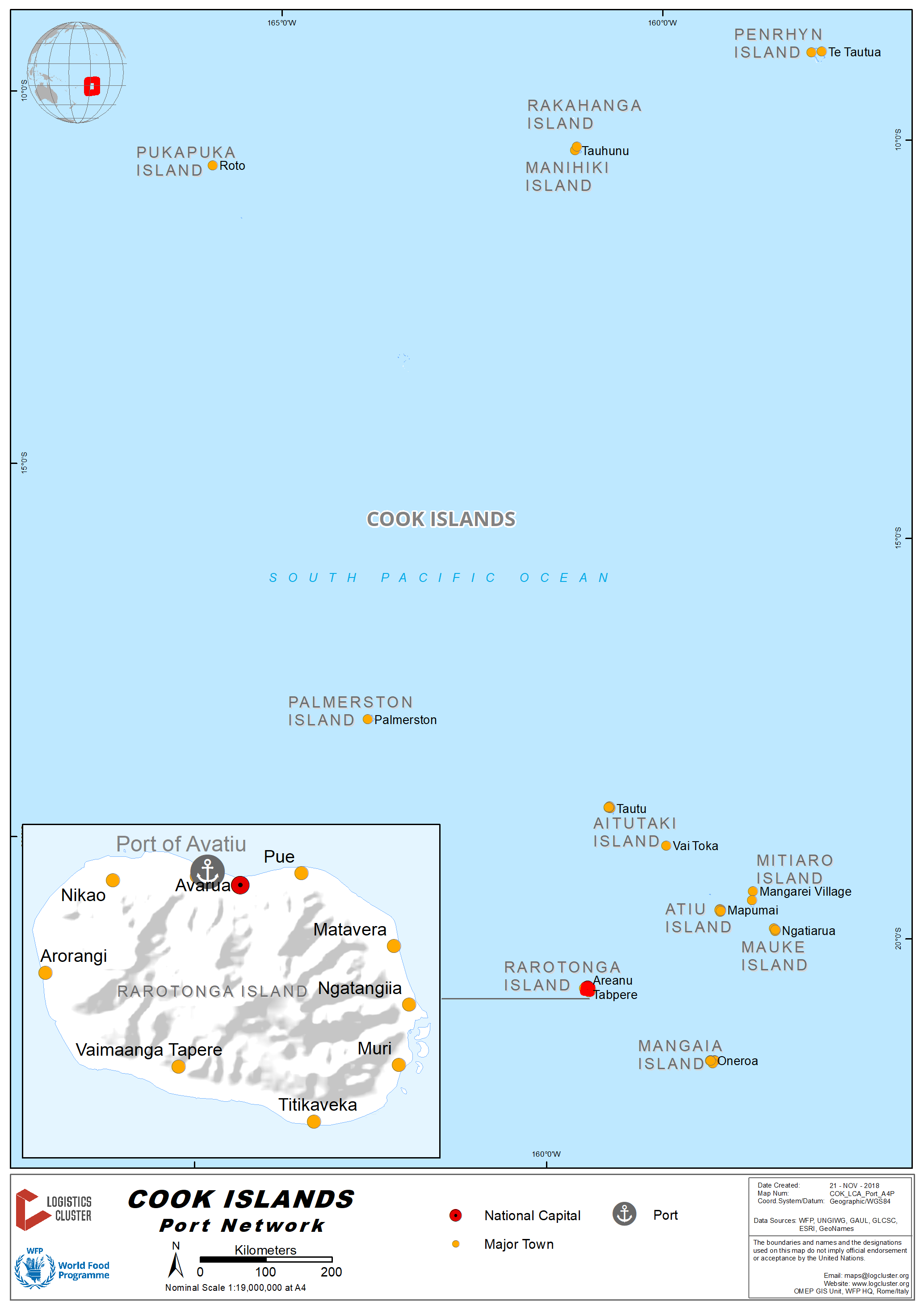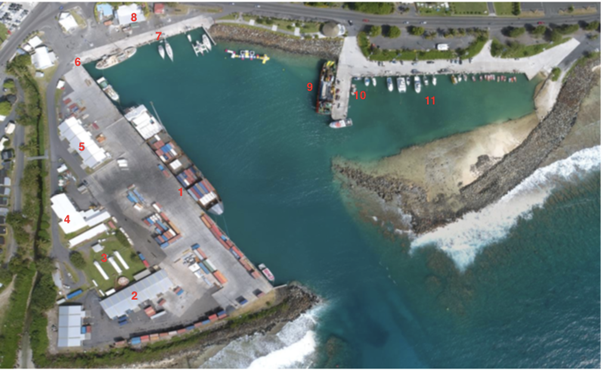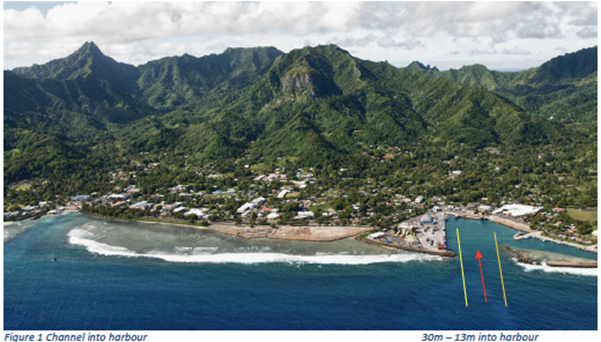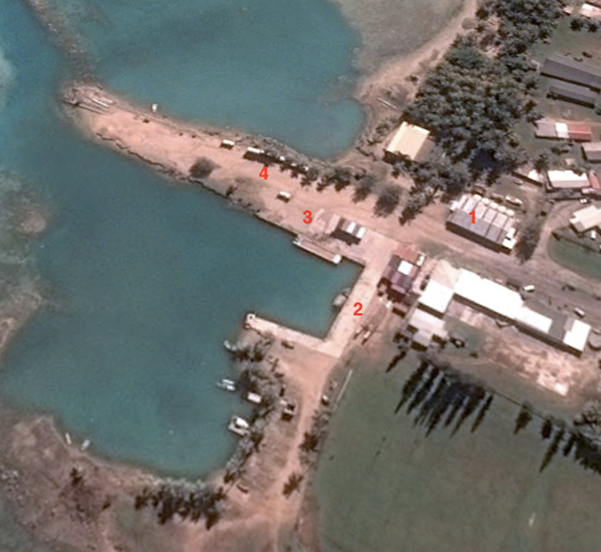2.1 Cook Islands Ports
The country has two ports of entry, the main port, Port of Avatiu on Rarotonga and Port of Arutanga, which serves the island of Aitutaki.
Port of Avatiu is capable of accommodating container and fuel tanker vessels up to 200 m in length and is responsible for handling almost all the country’s export and import cargo. A small percentage is taken directly to Aitutaki to service the needs of the locals and tourist resorts there, however large vessels cannot berth and cargo must be transhipped to shore by barge.
All the Outer Island harbours are small and shallow; freight shipped to these islands must be transferred to barges or other small vessels to be landed.
2.1.1 Cook Islands Port of Avatiu
Port Overview
The Ports Authority is a Crown owned Statutory Corporation established by Act of the Cook Islands Parliament. The objective of the Ports Authority is to provide commercially viable port facilities and develop growth opportunities from its assets which include Crown Land and buildings, wharves, port facilities, tug boats, barges, plant and equipment, storage sheds and open storage space
Port website: www.ports.co.ck/amenities.html
Key port information may also be found at: http://www.maritime-database.com
| Port Location and Contact | |
|
Country |
Cook Islands |
|
Province or District |
Rarotonga |
|
Nearest Town or City Distance from Port |
Avarua 0.5km |
|
Port's Complete Name |
Port Of Avarua |
|
Latitude |
|
|
Longitude |
159° 46' 0" W |
|
Managing Company or Port Authority |
Cook Islands Ports Authority |
|
Management Contact Person |
Nooroa (Bim)
Tou |
|
Nearest Airport and Airlines with Frequent International Arrivals/Departures |
Rarotonga International Airport Air NZ, Virgin Australia, Jet Star, Air Tahiti |
Port Picture
1 International Terminal 2 International Cargo (shed 2) 3 Origin Gas Terminal
4 Ports Workshop & Canteen Room 5 Domestic Cargo (shed 1) 6 Domestic Terminal
7 Southern Wall Wharf 8 Maritime Surveillance 9 Police Launch Berth 10 Tug Berth 11 Pleasure and fishing boats
Description and Contacts of Key Companies
The Ports Authority is responsible for the port. Its assets include buildings, wharves, port facilities, tugboats, plant and equipment, storage/transit sheds, open storage areas, and stacking areas for commercial purposes. It also maintains the channel, approach, berth depths, navigational aids, and wharves (piers, jetties).
It provides marshalling services for the movement of containerised, break-bulk and homogeneous cargoes. It also provides cargo handling equipment for containers and general cargo, and a container cleaning service.
There is a single stevedoring company; Cook Islands General Transport Ltd and a devanning company: HPM De-vanning that unpacks containers.
For more information on port contacts, please see the following link: 4.4 Port and Waterways Companies Contact List
Port Performance
Channel draft is from 30m from outside reef to 13m before entrance. Inside entrance at breakwaters is 10m depth.
Maximum length for vessel of more than 120m and up to 200m can either enter bow into berth and reverse out, or reverse into berth and exit bow first.
There is no congestion currently with about 60% occupancy. It does experience congestion from time to time when domestic vessels, international cargo vessels, expedition cruise ships and yachts (during yacht season, May–August) are all present. There is no established priority for humanitarian cargoes at present however there is in emergency situations.
Average waiting time between arrival and berthing, dependant on weather, is 1 – 2 hours. Winds over 20 knots will result in vessels being held offshore until they abate. This happens occasionally and irregularly.
|
Seasonal Constraints |
||
|---|---|---|
|
Occurs |
Time Frame |
|
|
Rainy Season |
Yes |
From April to July but no constraint |
|
Major Import Campaigns |
No |
|
|
Other Comments |
Vessels will not be unloaded on Sundays (Unless it is during cyclone season, Nov. to March, and prior permission is sought and received from the Island’s religious leaders) |
|
|
Handling Figures for 2018 |
|
|---|---|
|
Vessel Calls |
25 Container vessels 17 Tanker vessels |
|
Container Traffic (TEUs) |
3,632 |
|
Handling Figures Bulk and Break Bulk for 2018 (excluding container cargo) |
|
|---|---|
|
Bulk (MT) |
19,000 Revenue Ton 24,0004.611 litres (Fuel) |
|
Break bulk (MT) |
22,025 revenue Ton |
Fuel can be discharged from tanker vessels directly to the nearby fuel farms via underground pipe from the wharf.
Discharge Rates and Terminal Handling Charges
For information on port rates and charges, please see the following link: www.ports.co.ck
Berthing Specifications
|
Type of Berth |
Quantity |
Length (m) |
Maximum Draft (m) |
Comments |
|---|---|---|---|---|
|
Conventional Berth |
1 |
160 |
7 |
Maximum turning diameter in Port is 135m. Due to presence in airport flight path, air draft restriction of 27m |
|
Container Berth |
|
|||
|
Silo Berth |
N/a |
N/a |
N/a |
N/a |
|
Berthing Tugs |
1 |
20 |
3 |
Berths at the Marina |
|
Water Barges |
1 |
50 |
3 |
Berths at the Marina |
General Cargo Handling Berths
|
Cargo Type |
Berth Identification |
|
Imports - Bagged Cargo |
N/a |
|
Exports - Bagged Cargo |
N/a |
|
Imports and Exports - RoRo |
N/a |
|
Other Imports |
Port Handling Equipment
Equipment is owned and managed by the Ports Authority. Maintenance and repairs is carried out by external contractors
|
Equipment |
Available |
Total Quantity and Capacity Available |
Comments on Current Condition and Actual Usage |
|---|---|---|---|
|
Dockside Crane |
No |
||
|
Container Gantries |
No |
||
|
Mobile Cranes |
No |
||
|
Reachstacker |
Yes |
1 x 12 mt |
Maintained |
|
RoRo Tugmaster (with Trailer) |
No |
||
|
Grain Elevator with Bagging Machines |
No |
||
|
Transtainer |
No |
||
|
Forklifts |
Yes |
4 x 3 mt 1 x 40 mt |
Maintained |
Container Facilities
Containers are stacked (up to 3 high) on a tar sealed open-air storage area.
|
Facilities |
20 ft |
40 ft |
|---|---|---|
|
Container Facilities Available |
Storage areas for up to 238 TEU |
|
|
Container Freight Station (CFS) |
N/a |
N/A |
|
Refrigerated Container Stations |
20 refrigerated container power point sites |
|
|
Other Capacity Details |
||
|
Daily Take Off Capacity |
Capacity generally limited to trucking companies capacity. There are limited side lifters on the island (approximately 4). |
|
|
Number of Reefer Stations |
20 total |
|
|
Emergency Take-off Capacity |
150-200 (Provided there is space on the wharf area to stack them (238 TEU maximum) |
|
|
Off take Capacity of Gang Shift |
150-200 (Provided there is space on the wharf area to stack them (238 TEU maximum) |
|
Customs Guidance
Customs require:
- 5 days notice for cargo shipping
- 48 hours for cruise passengers (clearance procedures are required to be made at port of departure prior to Rarotonga)
Average clearance time for cargo shipping 1-2 hours.
Customs are available 24 hours if required (not available on Sundays)
For more information on customs in the Cook Islands, please see the following link: 1.3 Customs Information
Terminal Information
Multipurpose Terminal
There is one terminal. It is used for discharging/loading containerised and/or palletised cargo. It does not have Ro-Ro facilities. It does not have dockside cranes; ships’ cranes must be used.
Grain and Bulk Handling
There are no facilities available for grain and bulk handling at this Port.
Main Storage Terminal
There are 2 warehouse storage units on the international terminal and 1 on the domestic terminal. All these warehouse facilities are leased out to private companies. They are generally at 80% capacity.
There is no permanent cool store facility at the port. Goods requiring refrigeration are bought in chilled from offsite and loaded directly into refrigerated containers within 24 hours of their shipping date.
|
Storage Type |
Number of Storage Facilities |
Area (m2) |
|---|---|---|
|
Bagged Cargo |
Covered (3 sheds). Generally 80% full. Uncovered |
1,800 5,000 |
|
General Cargo |
||
|
Refrigerated Cargo |
19 connection points for Reefer containers. No other refrigerated storage facilities |
N/a |
Stevedoring
There is only one stevedoring company. They are responsible for unloading vessels using ships’ cranes. All marshalling and stacking of containers, once dockside, is carried out by the Ports Authority using their own equipment.
Hinterland Information
Containers are moved from the port using side lifter trucks owned by private companies. Currently (2018) there are only 4 side lifter trucks on the Island. Other cargo is unloaded from containers and loaded to small trucks for local distribution. Containers may be left on the wharf for 3 days at no charge, demurrage is charged after this time.
Port Security
Port security is in compliance with the ISPS Code and Cook Islands Customs Act. There is security present 24/7 at the International Terminal.
|
Security |
|
|---|---|
|
ISPS Compliant |
Yes |
|
Current ISPS Level |
1 |
|
Police Boats |
Yes. x 1 |
|
Fire Engines |
Yes (Rescue Fire Service) |
|
Port Location and Contact |
|
|
Country |
Cook Islands |
|
Province or District |
Rarotonga |
|
Nearest Town or City Distance from Port |
Avarua 0.5km |
|
Port's Complete Name |
Port Of Avarua |
|
Latitude |
|
|
Longitude |
159° 46' 0" W |
|
Managing Company or Port Authority |
Cook Islands Ports Authority |
|
Management Contact Person |
Nooroa (Bim) Tou |
|
Nearest Airport and Airlines with Frequent International Arrivals/Departures |
Rarotonga International Airport Air NZ, Virgin Australia, Jet Star, Air Tahiti |
2.1.2 Cook Islands Port of Arutanga, Aitutaki
Port Overview
Arutanga Harbour is the only mainstream operation port that serves Aitutaki internationally. It is managed by the Cook Islands Ports Authority, they also own and manage the equipment used dock-side and the barges.
It is a small harbour inside the reef with a narrow pass (about 30m wide) and shallow (about 1.6m)
Large ships anchor off and all cargo is shipped to dock by barge.
A concept proposal for the Port of Aitutaki involving the enlargement and deepening of the Aitutaki main entrance channel to accommodate local inter-Island ships and visiting yachts, and deepening the area in front of the existing fishing club for use as a marina, is to be undertaken as a long term project. No dates have been set for this work.
Port website: No port website
Key port information can also be found at: http://www.maritime-database.com
| Port Location and Contact | |
|
Country |
Cook Islands |
|
Province or District |
Aitutaki |
|
Nearest Town or City with Distance from Port |
Arutanga Adjacent |
|
Port's Complete Name |
Arutanga Port |
|
Latitude |
18.51S |
|
Longitude |
159.49W, |
|
Managing Company or Port Authority |
Cook Islands Ports Authority |
|
Management Contact Person |
Nooroa (Bim)
Tou |
|
Nearest Airport and Airlines with Frequent International Arrivals/Departures |
Rarotonga International Airport Air NZ, Jetstar, Virgin Australia |
Port Picture
1 CIPO office and storage 2 Container stacking area
3 Barge berth and container unloading area
4 Container stacking area
Description and Contacts of Key Companies
The port is is managed by the Cook Islands Ports Authority, they also own and manage the equipment used dockside and the barges used to transfer from larger ships to wharf. Stevedoring services are supplied by Baxter Boys Seana B Ltd.
For more information on port contacts, please see the following link: HQ staff will input a link to section 4.4 Port and Waterways Companies Contact List here.
Port Performance
The port links Aitutaki to the main Island Rarotonga and New Zealand. The port is not congested and receives ships on average every 6 weeks. The shallow channel draft means all shipping anchors off and cargo is transferred to wharf by barge. General turnaround time is 20 containers per day (2/barge trip/hour) however in rough or windy weather unloading may be restricted or not possible at all.
|
Seasonal Constraints |
||
|---|---|---|
|
Occurs |
Time Frame |
|
|
Rainy Season |
No |
|
|
Major Import Campaigns |
No |
|
|
Other Comments |
|
|
|
Handling Figures for 2018 |
|
|---|---|
|
Vessel Calls |
12 |
|
Container Traffic (TEUs) |
470 |
|
Handling Figures Bulk and Break Bulk for |
|
|---|---|
|
Bulk (MT) |
N/a |
|
Break bulk (MT) |
67MT |
Discharge Rates and Terminal Handling Charges
For information on port rates and charges, please see the following link: www.ports.co.ck
Berthing Specifications
|
Type of Berth |
Quantity |
Length (m) |
Maximum Draft (m) |
Comments |
|---|---|---|---|---|
|
Conventional Berth |
N/a |
N/a |
N/a |
A 1.6 m draft at harbour entrance means no ships enter. |
|
Container Berth |
N/a |
N/a |
N/a |
|
|
Silo Berth |
N/a |
N/a |
N/a |
|
|
Berthing Tugs |
N/a |
N/a |
N/a |
|
|
Water Barges |
N/a |
N/a |
N/a |
|
General Cargo Handling Berths
|
Cargo Type |
Berth Identification |
|
Imports - Bagged Cargo |
N/a |
|
Exports - Bagged Cargo |
N/a |
|
Imports and Exports - RoRo |
N/a |
|
Other Imports |
N/a |
Port Handling Equipment
The port handling equipment, including barges, is owned and operated by the Ports Authority
|
Equipment |
Available |
Total Quantity and Capacity Available |
Comments on Current Condition and Actual Usage |
|---|---|---|---|
|
Dockside Crane |
No |
N/a |
|
|
Container Gantries |
No |
N/a |
|
|
Mobile Cranes |
Yes |
20T |
Maintained |
|
Reachstacker |
No |
N/a |
|
|
RoRo Tugmaster (with Trailer) |
No |
N/a |
|
|
Grain Elevator with Bagging Machines |
No |
N/a |
|
|
Transtainer |
No |
N/a |
|
|
Forklifts |
Yes |
|
Maintained |
Container Facilities
|
Facilities |
20 ft |
40 ft |
|---|---|---|
|
Container Facilities Available |
Uncovered stacking areas dockside for approximately 60 TEU
|
|
|
Container Freight Station (CFS) |
N/a |
N/a |
|
Refrigerated Container Stations |
N/a |
N/a |
|
Other Capacity Details |
N/a |
N/a |
|
Daily Take Off Capacity |
N/a |
N/a |
|
Number of Reefer Stations |
N/a |
N/a |
|
Emergency Take-off Capacity |
20/day |
10/day |
|
Off take Capacity of Gang Shift |
20/day |
10/day |
Customs Guidance
Customs have an officer based full time on the island who will be available to clear any shipping arrivals. Generally ships pass through the Port of Avatiu (Rarotonga) en route so customs clearance will have taken place there. They are capable of immigration and quarantine duties as necessary.
For more information on customs in the Cook Islands, please see the following link: 1.3 Customs Information
Terminal Information
Multipurpose Terminal
There are no multipurpose terminals available. Large ships are anchored off and unloaded to wharf via barge 2 x 20’ containers maximum load at a time.
Grain and Bulk Handling
There is no bagged or bulk grain handling facilities.
Main Storage Terminal
There is a covered and secure storage building that also houses the Port Authority offices on a mezzanine floor.
|
Storage Type |
Number of Storage Facilities |
Area (m2) |
|---|---|---|
|
Bagged Cargo |
1 |
300 |
|
Refrigerated Cargo |
There are no refrigerated container points |
N/a |
|
General Cargo |
1 (same as for bagged above) |
|
Stevedoring
Stevedoring services are supplied by Baxter Boys Seana B Ltd. a local firm. Local labour is sourced. They are responsible for operating shipboard cranes used to load cargo onto the barges. The Ports Authority employees are responsible for stacking and marshalling container and break bulk cargo once it has been unloaded from the ship to the barge and then wharf. No unloading can occur on a Sunday due to religious beliefs.
Hinterland Information
There is one side lifter truck available for transportation of 20’ containers around the island. Generally cargo is unloaded from containers in the dock area and transferred to small trucks for distribution.
Port Security
Whilst security is not heavy at the port, due to the isolated and compact nature of the island and its population it is not overly required. However the Ports Authority have ensured it is ISP compliant.
|
Security |
|
|---|---|
|
ISPS Compliant |
Yes |
|
Current ISPS Level |
1 |
|
Police Boats |
No |
|
Fire Engines |
No |




